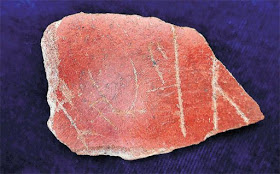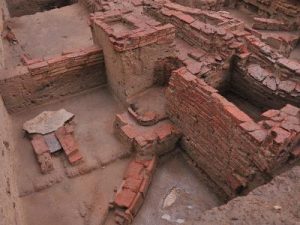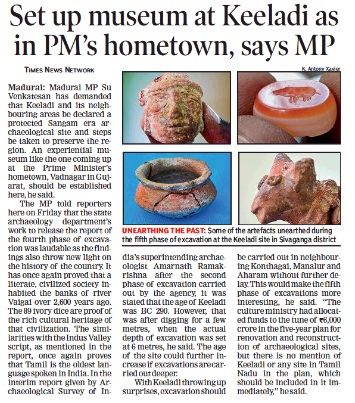 வரலாற்றின் பொருளைக் காண்பதில் இருவிதச் சிந்தனைப் போக்குகள் இருக்கின்றன. தற்காலத் தேவைகளை கடந்த காலத்தில் காண முயல்வதும், பழங்காலத்தின் படிமத்தைத் தற்காலத்தின்மீது பதிக்க முயல்வதும் அவ்விரு போக்குகளாகும். – ரொமீலா தாப்பர்
வரலாற்றின் பொருளைக் காண்பதில் இருவிதச் சிந்தனைப் போக்குகள் இருக்கின்றன. தற்காலத் தேவைகளை கடந்த காலத்தில் காண முயல்வதும், பழங்காலத்தின் படிமத்தைத் தற்காலத்தின்மீது பதிக்க முயல்வதும் அவ்விரு போக்குகளாகும். – ரொமீலா தாப்பர்
கீழடி அகழாய்வு பற்றிய அறிமுகக் கட்டுரையினைக் கடந்த இதழில் எழுதியிருந்தேன். கீழடி அகழாய்வினை இந்திய அரசு தாமதப்படுத்துவதாகவும், புறக்கணிப்பதாகவும், உள்நோக்கத்துடன் அகழாய்வின் கண்காணிப்பாளர் இடமாற்றம் செய்யப்பட்டதாகவும் பல்வேறுவிதமான விமர்சனங்கள் தமிழகச் சூழலில் எழுந்துள்ளன. இவ்விமர்சனங்களுடன் சேர்ந்தே இங்கொரு கருத்துருவும் முன்வைக்கப்பட்டு வருகின்றது. அது யாதெனில், கீழடி நாகரிகமானது சமயச்சார்பற்றது என்பதே ஆகும். இந்தக் கருத்துருவின் நோக்கமானது, எவ்வளவிற்கு வரலாற்று அறிதலில் தமிழ் இனவாத மற்றும் போலி மதச்சார்பின்மை வாதங்களினால் வரலாற்றுத்திரிபைச் சாத்தியப் படுத்தக்கூடுமென்ற எச்சரிக்கையுணர்வுடன் அணுகப்பட வேண்டிய ஒன்றாகும்.
வரலாற்றில் தமிழர்கள் கடைபிடித்திருந்த பௌத்த, ஜைன மதங்கள் வந்தேறி மதங்கள், அதற்கு முன்பு தமிழர்கள் தமக்கென்று தனிச்சிறப்பான மதத்தினைக் கொண்டிருந்தார்கள், அவற்றை அழித்துவிட்டு இம்மதங்கள் தமிழனை அடிமைப்படுத்திவிட்டன – என்பது போன்ற எவ்வித வரலாற்று அடிப்படைகளுமற்ற வாதங்களை முன்வைத்து வரும் தமிழ் இனவாதப் போக்குகள் ஒருபுறம். வளர்ச்சியடைந்திருந்த சங்ககால வர்க்கச் சமூகமென்பது சமயமற்ற சமூகமாக இருந்திருக்க வாய்ப்பில்லை என்ற வரலாற்றுப் பொருள்முதல்வாத அணுகுமுறையற்ற மொன்னைத்தனமான, தமிழ் இனவாத ஆதரவு மறுபுறம். இவ்வகையான வாதங்கள் கறாரான வரலாற்றின் முன் நொறுங்கிப் போகுமளவிற்கு பலவீனமானவை என்ற போதிலும், இவற்றின் சமகாலத் தேவையினை வரலாற்றில் நிறுவ முயலும் போக்குகளைத் தோலுரிப்பதும் அவசியமாகும். ஏனெனில் தமிழரின் தொல்சமயமாக தொல்லியல், வரலாற்றியல் பொருண்மைகளின் அடிப்படையில் நமக்கு இதுவரை கிடைத்திருப்பது எல்லாமே அவைதீக சமயங்களான பௌத்த, மற்றும் பிற்காலத்திய ஜைன சமயங்களே ஆகும். இதர சைவ, வைணவ சமயங்களும் பிற்காலத்தவையே. அசலான நிலைமைகள் இவ்வாறிருக்க தமிழருக்கென்று இல்லாதிருந்த சமயத்தின் மீதான ஏக்கமும், உண்மையில் இருந்த சமயத்தின் மீதான வரலாற்றுக் குருட்டுத்தனங்களும் வழிநடத்தும் வாதங்கள் மெய்ம்மையை அறிய ஒரு போதும் உதவாது.
போலி மதச்சார்பின்மைவாதிகளைப் பொறுத்த மட்டில், அவர்களின் வாதங்களின் அடியிலுள்ளவை தமது மதம்சார் பெரும்பான்மை அடிப்படைவாதத்துடன் கூடிய அரசியற் பொருளியல் மேலாதிக்கமேயாகும். இவர்களின் தொடர்ச்சியான வரலாற்றுத் திரிபு வேலைகள் அவ்வப்போது அம்பலப்பட்டு வந்தாலும், தொடர்ச்சியான போலி வரலாற்றுக் கட்டமைப்பில் தொடர்ந்து மேலாதிக்கமே செய்துவருவது இவைதமது ஆளும் வர்க்கநிலைகளின் அதிகாரத்தினாலே ஆகும்.
அவர்களின் வாதங்களின் அடியிலுள்ளவை தமது மதம்சார் பெரும்பான்மை அடிப்படைவாதத்துடன் கூடிய அரசியற் பொருளியல் மேலாதிக்கமேயாகும். இவர்களின் தொடர்ச்சியான வரலாற்றுத் திரிபு வேலைகள் அவ்வப்போது அம்பலப்பட்டு வந்தாலும், தொடர்ச்சியான போலி வரலாற்றுக் கட்டமைப்பில் தொடர்ந்து மேலாதிக்கமே செய்துவருவது இவைதமது ஆளும் வர்க்கநிலைகளின் அதிகாரத்தினாலே ஆகும்.
ஆக ரொமீலா தாப்பர் போன்ற, ‘நவீன வரலாற்றெழுதியலை’ முன்வைக்கும் அறிஞர்கள் சுட்டிக்காட்டியுள்ளதைப் போன்ற வரலாற்றுப் போக்குகளை இனங்கண்டு, வரலாற்றினை நேர்செய்தல் என்னும் பொறுப்புணர்விலிருந்தும் எனது சில அவதானிப்புகளை இங்கே முன்வைக்கின்றேன்.
கீழடி அகழாய்வில் கிடைத்த தமிழி (அ) தமிழ்-பிராமி எழுத்துகள் சிலவற்றைப் பற்றி ஆராய்கையில் எனக்குக் கிடைத்த சில விவரங்களை இவ்விடத்தில் பகிர்கிறேன்.
தமிழி ( அ ) தமிழ்-பிராமி எழுத்துக்கள் :
கீழடி, பள்ளிச்சந்தை திடலில் கண்டுபிடிக்கப்பட்ட தொல்பொருட்களிடையே சுமார் பதினெட்டு மட்பாண்டச்சில்லுகளில் தமிழ்-பிராமி எழுத்துருக்கள் கண்டறியப்பட்டிருக்கின்றன. அச்சில்லுகளில் வேந்தன், சேந்தன் அவதி, சந்தன், சாத்தன், மடைசி, எரவாதன், உத்திரை, ஆதன், முயன், இயனன், திஸன், குவிரன், குலவன், உலசன், வணிகப்பெருமூவர் உண்கலம், போன்ற தமிழ் மற்றும் பிறமொழிச் சொற்களும் கிடைக்கப் பெற்றுள்ளன.
1) திஸன் :
- இலங்கை அம்பாறை மாவட்டத்திலுள்ள கொடுவில்லில் கி.மு. இரண்டாம் நூற்றாண்டைச் சேர்ந்த கல்வெட்டொன்று ‘திஸ’ என்னும் பெயருடைய தமிழ் பெருவணிகனொருவன் அங்குள்ள பௌத்த சங்கத்துக்கு தானம் வழங்கிய செய்தியைத் தெரிவிக்கின்றது.
- இலங்கையில் கண்டுபிடிக்கப்பட்ட கல்வெட்டுகளில் சுமார் 15 கல்வெட்டுகளில் ‘திஸ’ எனும் பெயர் இடம்பெற்றுள்ளது. வணிக சமூகத்தில் ‘திஸ’ ஒரு தனிச்சிறப்பு மிக்க நிலையைக் குறிப்பதாக இலங்கை ஆய்வாளர் புஷ்பரத்னம் கருதுகிறார்.
- ‘திஸக’ என்னும் பெயர் ஒட்டுக் கொண்டவர்கள் அரச தூதுவர்களாகவும், மரக்கலங்களின் தலைவர்களாகவும், பெரும்வணிகர்களாகவும் விளங்கியதை முறையே குர்ணகலா, பரமகண்டா, கொடுவில் போன்ற இலங்கைப் பகுதிகளில் கண்டெடுக்கப்பட்ட கல்வெட்டுகள் மூலம் அறிய முடிவதாக பரனவிதான குறிப்பிடுகிறார்.
- கி.மு. மூன்றாம் நூற்றாண்டில் இலங்கையை அரசாண்ட ‘தேவனாம்பிய திஸன்’ என்பவர் தமது உறவினரான அரிட்டர் என்பவரை தமிழகத்தில் பௌத்த சங்கப் பணிகளுக்காக பெரும் பொருளுதவி செய்து அனுப்பியிருக்கிறார். அந்த அரிட்டரே மதுரை அரிட்டாபட்டியில் தங்கியிருந்து பௌத்த சங்கப் பணிகளில் செயல்பட்டவராவார் என்பது அறிஞர் மயிலை.சீனி.வேங்கடசாமி அவர்களின் கூற்று.
- இலங்கையிலே கி.மு.இரண்டாம் நூற்றாண்டில் ‘ராஸஹெல’ என்னும் இடத்திலுள்ள மலைக்குகைகளிலே வசித்து வந்த பௌத்தத் துறவியருக்கு ‘சத்தா திஸ்ஸன்’ என்னும் அரசனின் மகன்கள் இருவர் தானம் வழங்கியமையை அவ்விடத்திலே உள்ள கல்வெட்டுகள் அறிவிக்கின்றன. ‘மஹாஅய’, ‘நிஸ்ஸஅய’ என்வன அவர்தம் பெயர்கள். ‘மஹா அயன்’ முடிசூட்டிக்கொண்டபின் ‘லாஞ்ச திஸ்ஸன்’ என்னும் பெயருடன் அரசாண்டான். ‘திஸ்ஸ அய’ என்பது திஸ்ஸன் எனும் பெயருடைய அரசன் என்னும் பொருள் தருவதாகும். இலங்கை அரச குடும்பத்தைச் சார்ந்தவர்களுக்கு ‘அய’ எனும் பின்னொட்டு வழங்குவதை பல கல்வெட்டுகள் மூலமும் நிறுவுகிறார் மயிலையார்.
- பூம்புகார் பட்டினத்திலும் பல பிராகிருதச் சொற்கள் கொண்ட பானை ஓடுகள் கிடைக்கப் பெற்றதாக தொல்லியலாளர் கா.ராஜன் கூறுகிறார். ஈழத்திலிருந்து புகார்ப்பட்டினத்திற்கு உணவுப்பொருட்கள் வந்துள்ளதை பட்டினப்பாலை கூறுவதாகவும் குறிப்பிடுகிறார்.
- அரிக்கமேடு, காவேரிப்பட்டினம், அழகன்குளம், கொடுமணல் ஆகிய ஊர்களில் அகழ்ந்தெடுக்கபட்ட பானை ஓடுகளில் இலங்கைக்கே உரித்தான சொற்கள் தமிழியில் (பிராமியில்) கீறப்பட்டிருப்பதாக ஐராவதம் மகாதேவனும் குறிப்பிட்டுள்ளார்.
 ‘திஸன்’ என்னும் சொல்லானது இலங்கைக்கே உரிய சொல் ஆகும். இச்சொல் பாலி மற்றும் பிராகிருதம் ஆகிய இரு மொழிகளிலும் பயின்று வருகிறது. அது பௌத்த சங்கங்களுக்கு தானம் வழங்கிய அரசர்களையோ பெருவணிகர்களையோ குறிப்பதாகும். ‘திஸன்’ என்னும் சிறப்புப் பெயர் தாங்கிய தமிழ் பரதவப் பெருவணிகர்களும் இவ்வாறே தொண்டாற்றிச் சிறப்பிக்கப் பெற்றுள்ளார்கள். அவர்கள் ‘பரததிஸக’ என்னும் பெயர் பொறித்த காசுகளையும் வெளியிடும் அளவுக்குக் கோலோச்சியிருக்கிறார்கள்.
‘திஸன்’ என்னும் சொல்லானது இலங்கைக்கே உரிய சொல் ஆகும். இச்சொல் பாலி மற்றும் பிராகிருதம் ஆகிய இரு மொழிகளிலும் பயின்று வருகிறது. அது பௌத்த சங்கங்களுக்கு தானம் வழங்கிய அரசர்களையோ பெருவணிகர்களையோ குறிப்பதாகும். ‘திஸன்’ என்னும் சிறப்புப் பெயர் தாங்கிய தமிழ் பரதவப் பெருவணிகர்களும் இவ்வாறே தொண்டாற்றிச் சிறப்பிக்கப் பெற்றுள்ளார்கள். அவர்கள் ‘பரததிஸக’ என்னும் பெயர் பொறித்த காசுகளையும் வெளியிடும் அளவுக்குக் கோலோச்சியிருக்கிறார்கள்.
மதுரையில் அன்று செழிப்பாகப் பரவியிருந்த பௌத்த சமயத் துறவிகளுக்கு அணுக்கமானவர்களாக இருந்து மட்பாண்டக் கலங்களில் உணவுப் பொருட்களை ‘திஸன்’ என்று குறிப்பிடப்பெறும் செல்வாக்குமிக்க மனிதர் வழங்கியிருக்க வாய்ப்பிருப்பதாகக் கருத இடமுண்டு (அவர் எந்த ‘திஸன்’ என்பது மேலதிக ஆய்வுக்கு உட்பட்டது). கல்வெட்டு மற்றும் மட்பாண்டச் சான்றுகள் இக்கருத்துக்கு வலுச்சேர்க்கும் விதமாகவே அமைந்துள்ளது குறிப்பிடத்தக்கதாகும். ஆக கீழடி நகர நாகரீகத்திற்கும் பௌத்த சமயத்திற்கும் உள்ள தொடர்பு குறித்த முதற்சான்றாக இந்த ‘திஸன்’ திகழ்கிறான்.
2) சாத்தன் :
- சாத்தன் அல்லது சாத்தனார் என்பதை சாஸ்தா என்னும் வடமொழிச்சொல்லின் திரிபென அடையாளம் காண்கிறார் அறிஞர். மயிலை.சீனி.வேங்கடசாமி.
- சாஸ்தா, சாத்தன் என்பவை புத்தரைக் குறிக்கும் பெயர்கள் என்பதாகவே ‘அமரகோசம்’, ‘நாமலிங்ககானுசாசனம்’ முதலிய வடமொழி நிகண்டுகளும், ‘சேந்தன் திவாகரம்’, ‘சூடாமணி’, போன்ற தமிழ் நிகண்டுகளும் கூறுகின்றன.
- சங்க காலத்தில் பரவலாக சாத்தன் என்னும் பெயர் காணப்படுவதிலிருந்தும், அதன் சொற்பிறப்பியல் அடிப்படையிலும் பௌத்த மார்க்கத்தைத் தழுவி ஏற்றோரே அப்பெயரைத் தமக்கோ தம் பிள்ளைகளுக்கோ சூடியிருத்தல் வேண்டுமென அறிஞர்கள் கருதுகின்றனர்.
- ‘பெருந்தலைச் சாத்தனார்’, ‘மோசி சாத்தனார்’, ‘வடமவண்ணக்கன் பெருஞ்சாத்தனார்’, ‘ஒக்கூர் மாசாத்தனார்’, ‘கருவூர்க் கதப்பிள்ளை சாத்தனார் போன்ற பெயர்களைக் கொண்ட சங்ககாலப் புலவர்களும் பௌத்தர்களாக இருந்திருக்கக் கூடும் என்று அவர்கள் கொண்டிருந்த சாத்தன் என்னும் பெயரைக் கொண்டு கருதுகிறார் மயிலை.சீனி.வேங்கடசாமி.
- பௌத்தத் துறவியருக்கான குகைத்தளங்களின் புருவப்பகுதி கல்வெட்டுகளிலும் சாத்தன் என்னும் பெயர் இடம் பெற்றுள்ளது.
சாத்தன் என்னும் சொல் பற்றி மட்டும் மேலும் விவரித்துக்கொண்டே செல்ல இயலும். ஆக கீழடி நாகரிகத்துக்கும் பௌத்த சமயத்துக்குமான தொடர்பினைக் குறிக்கும் சொல்லாக சாத்தனைக் கருத இடமுண்டு.
3) ஆதன் :
- ஆதன் என்னும் பெயர் புத்தருக்குரிய பெயரென்றெ சூடாமணி நிகண்டு குறிப்பிடுகின்றது.
- மன்னார்சாமியாகிய புத்தரும் தமிழ்நாட்டில் இன்றும் மன்னாதன் என்னும் பெயரில் வழிபடப்பெறுகிறார்.
- மதுரையைச் சுற்றிலும் அமைந்திருக்கும் பௌத்தத் துறவியருக்கான குகைத்தளங்கள் சிலவற்றில் அவற்றை அத்துறவியருக்கென கொடுப்பித்த ஆதன் என்பவரின் பெயர் இடம்பெற்றிருப்பதும் இங்கு நோக்கத்தக்கது.
- ஆதன் அழிசி, ஆதன் எழினி, ஆதனுங்கன், ஆதன் ஓரி, ஆதன் அவினி போன்ற பெயர்களைக் கொண்ட சங்ககால மன்னர்கள் பற்றி சங்க இலக்கியங்கள் குறிப்பிடுகின்றன. மேலும் சங்ககாலப் பாடல்களில் நிறைய இடங்களில் ஆதன் என்னும் பெயர் இடம் பெறுகிறது.
- 4) சந்தன் :
மதுரை அழகர் மலையில் அமைந்துள்ள பௌத்தத் துறவியருக்கான குகைத் தளத்தில் கி.மு. முதல் நூற்றாண்டைச் சேர்ந்த கல்வெட்டில் ‘கொழு வணிகன் எள சந்தன்’ என்னும் பெயர் குறிப்பிடப் பெற்றுள்ளது. அதே குகைத்தளத்தில் ‘தியன் சந்தன்’ என்னும் பெயரும் காணப்படுகின்றது.
- மதுரை மேட்டுப்பட்டி சித்தர்மலையில் பஞ்சபாண்டவர் படுக்கை என வழங்கப்பெறும் பௌத்தத் துறவியருக்கான குகைத்தளத்திலும் கி.மு. இரண்டாம் நூற்றாண்டைச்சேர்ந்த ‘சந்தந்தை சந்தன்’ என்னும் பெயர் குறிப்பிடப்பெற்றுள்ளது.
சங்ககாலத்தில் பௌத்தத் துறவியருக்கானதாக இருந்த இக்குகைத்தளங்களில் காணப்பெறும் பெயர்கள் இவற்றை செம்மைப்படுத்திக் கொடுப்பித்த அடியவர்களின் பெயர்களாகவே அறியப்பெற்றிருக்கின்றன.
- 5,6,7) சேந்தன், எரவாதன், குவிரன் :
மதுரை மேட்டுப்பட்டியில் மேற்கண்ட அதே இடத்தில், ‘அந்தை சேந்தன் ஆதன்’ என்னும் பெயர் பொறிக்கப்பெற்ற கி.மு.இரண்டாம் நூற்றாண்டைச் சேர்ந்த கல்வெட்டொன்று காணப்படுகிறது.
- அவ்விடத்திலேயே, ‘அந்தை இரவாதன்’ என்னும் கல்வெட்டும்,
- குவிர அந்தை சேய் ஆதன்’, ‘குவிரந்தை வேள் ஆதன்’ என்னும் கல்வெட்டுகளும் காணப்படுகின்றன.
- மதுரை விக்கிரமங்கலத்திலுள்ள கி.மு.இரண்டாம் நூற்றாண்டைச் சேர்ந்த குகைக் கல்வெட்டுக்களில் முறையே, ‘பேதலை குவிரன்’, ‘செங்குவிரன்’, ‘குவிரதன்’ என்னும் பெயர்கள் காணப்படுகின்றன.
தற்காலிகமான நிறைவாக :
கீழடி நகர நாகரிகத்தின் காலமானது கி.மு. மூன்றாம் நூற்றாண்டு முதற்கொண்ட சங்க காலமென்பது சமீபத்திய கரிம சோதனைகளின் முடிவாக நாம் அறிந்ததே ஆகும். அதே காலகட்டத்தைச் சேர்ந்த, மதுரையைச் சுற்றியமைந்த பௌத்தத் துறவியருக்கான குகைக் கல்வெட்டு ஆதாரங்களுடன் ஓர் ஒப்பு நோக்கலே இக்கட்டுரையின் வாயிலான என் அவதானிப்புகளாகும். மேலும் இதன் மூலமாக ‘சமயச்சார்பற்ற கீழடி’ என்னும் வெற்றுப் பெருமிதத்தையும், அதன் வழியான போலி மதச்சார்பின்மை வாதங்களையும், கீழடி குறித்த தமிழ் இன வாதப் போக்குகளையும் கறாரான வரலாற்றெழுதியலை முன்வத்து எதிர்கொள்ள சிறு முயற்சியொன்றையும் மேற்கொண்டிருப்பதாகக் கூறிக்கொண்டு தற்காலிகமாக நிறைவு செய்கிறேன்.
காலமென்பது சமீபத்திய கரிம சோதனைகளின் முடிவாக நாம் அறிந்ததே ஆகும். அதே காலகட்டத்தைச் சேர்ந்த, மதுரையைச் சுற்றியமைந்த பௌத்தத் துறவியருக்கான குகைக் கல்வெட்டு ஆதாரங்களுடன் ஓர் ஒப்பு நோக்கலே இக்கட்டுரையின் வாயிலான என் அவதானிப்புகளாகும். மேலும் இதன் மூலமாக ‘சமயச்சார்பற்ற கீழடி’ என்னும் வெற்றுப் பெருமிதத்தையும், அதன் வழியான போலி மதச்சார்பின்மை வாதங்களையும், கீழடி குறித்த தமிழ் இன வாதப் போக்குகளையும் கறாரான வரலாற்றெழுதியலை முன்வத்து எதிர்கொள்ள சிறு முயற்சியொன்றையும் மேற்கொண்டிருப்பதாகக் கூறிக்கொண்டு தற்காலிகமாக நிறைவு செய்கிறேன்.
துணை நின்ற நூல்கள்:
- தொல்லியல் நோக்கில் சங்க காலம் – முனைவர்.கா.ராஜன்
- பௌத்தமும் தமிழும் – மயிலை.சீனி.வேங்கடசாமி
- வரலாறும் வக்கிரங்களும் – ரொமீலா தாப்பர்
- சங்க கால ஆய்வுகள் – மயிலை.சீனி.வேங்கடசாமி \
- சேந்தன் திவாகர நிகண்டு
- சூடாமணி நிகண்டு
இலங்கையிலும், தென்னிந்தியாவிலும், பண்டைய காலத்தில் தமிழர்கள் மஹாயாண பௌத்தர்களாக இருந்தனர் என்பதற்கு ஆயிரக்கணக்கான இலக்கிய, தொல்பொருள் சான்றுகள் உள்ளன. தமிழ் மொழியின் சொல் – பொருள் தொடர்பினை தொல்காப்பியனின் ”மொழிப் பொருட்காரணம் விழிப்பத் தோன்றா” என்பதற்கு நச்சினார்க்கினியர் எழுதிய உரையுடாக ஆராய்ந்து அறிய முடியாத நிலையிலும், புத்தபெருமானும், பௌத்தமும் எப்படி அடையாளப்படுத்தப்படலாம் என்பதை ஆராய்ந்து அறியாத நிலையிலும், இலங்கை, இந்தியத் தொல்பொருட்களில் காணப்படும் அடையாளங்கள் எவற்றை அடையாளப்படுத்துகின்றன என்பதை அறிய முடியாதவர்களாகத்தான் இன்றைய தொல்லியல் ஆய்வாளர்கள் உள்ளனர். இதனால், பௌத்த எச்சங்களை எல்லாம், அவர்கள் தமது குறிக்கோளுக்கேற்ப ஜைனம், ”இந்து” என்பவைகளுடன் பிழையாகவும், கற்பனையாகவும் இணைத்து வந்துள்ளனர். இலங்கை, தென்னிந்திய தொல்பொருட்களுள் மிகப் பெரும்பான்மையானவை மஹாயாண பௌத்தம் சார்ந்தவை. தேரவாத பௌத்தம் புத்தபெருமானும், பௌத்தமும் அடையானப்படுத்தவதை முழுமையாக நிராகரிக்கிறது!! தமிழ் இலக்கியங்களிலும் மிகப் பெரும்பான்மையானவை மஹாயாண பௌத்தம் சார்ந்தவை. இலங்கையின் சிங்கள தேரவாத பௌத்தர்களும், பிழையான, கற்பனையான முடிவுகளின் அடிப்படையில் கோட்பாட்டினை உருவாக்கி நாட்டை ஆள்வதுதான் இலங்கையின் பிரச்சினைக்கான மூலக்காரணம். அதாவது அறியாமைதான்!!









